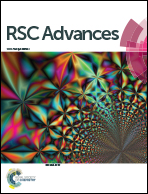Highly sensitive “turn-on” fluorescence probe for the detection of sparfloxacin in human serum using silica-functionalized CdTe quantum dots†
Abstract
In this study, an environment-friendly hydrothermal synthesis of hydrophilic silica-functionalized CdTe quantum dots (SQDs) has been developed by treatment of tetraethyl orthosilicate (TEOS) in the presence of CdTe QDs. The proposed SQDs show favorable photoluminescence (PL) at the peak wavelength of 620 nm with a quantum yield of approximately 32%, and exhibit excellent selectivity and sensitivity toward sparfloxacin (SPFX) in the range from 0.05 × 10−6 to 200 × 10−6 mol L−1. The detection limit of SPFX is as low as 0.035 × 10−6 mol L−1. The results show that the remarkably enhanced PL intensity of SQDs can be attributed to the hydrogen-bond interactions between the SQDs and SPFX. Furthermore, the amount of SPFX in the human serum samples detected by the present method and HPLC are in good agreement, indicating that the proposed SQDs can serve as a powerful tool for biological analysis.


 Please wait while we load your content...
Please wait while we load your content...